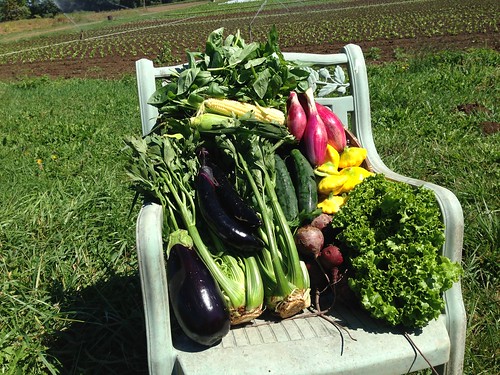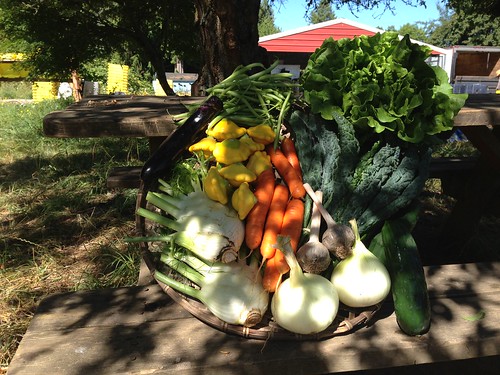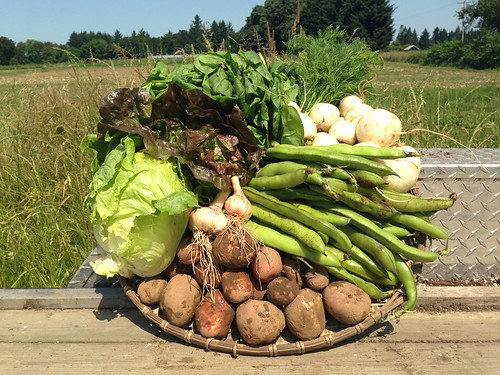A few more stews and slightly cooler weather meals here this week. These episodic showers have brought me back into the kitchen for some more slowly-cooked dishes. As usual I call for a variety of herbs (mint, tarragon, parsley and dill) in the below recipes so pick some of those up if you’re tempted by any of the ideas. The Potatoes Gribiche (calling for tarragon and parsley) are an all-time favorite. By all means try the German braised cucumbers. It’s an unusual treatment for Americans but was a childhood favorite and may just convince you to cook cucumbers more often.
Eggplant and Chickpea Stew
Green Sauce
Roasted Carrots and Potatoes with Green Sauce
Eggplant and Green Sauce Sandwiches or Wraps
Roasted Potato Salad (Gribiche)
Cucumber Sesame Salad with Peanuts
Schmorgurken (German Braised Cucumbers)
Pasta “Carbonara” with Greens
Eggplant and Chickpea Stew
With the occasional showers these days I’m starting to feel like cooking a bit more and this stew fits the bill. I imagine you have a few tomatoes lying around even if you don’t have them in your share yet.
3 tablespoons olive oil
2 medium eggplants (best with Italian Globe eggplants but works with Japanese as well)
1 large onion, finely diced
¾ teaspoons cumin seeds
Salt
5 cloves garlic
1-2 teaspoons Aleppo pepper flakes (to taste) or ½ teaspoon red pepper flakes
2 tablespoons pomegranate molasses (or 1 tablespoon honey and 2 teaspoons lemon juice)
2 ½ cups vegetable or chicken broth or water or chickpea cooking liquid
2 cups cooked chickpeas (rinsed, from a can or home-cooked)
2 bay leaves
1 ½ – 2 cups diced tomatoes
1 small bunch kale, de-stemmed, washed and finely chopped
Hot bulgur or rice for serving (optional)
Greek yogurt for serving
Preheat oven to 450 degrees. Cut eggplants in half and score deeply with a knife a couple of times. Put on a sheet pan and roast until very tender about 25-30 minutes. Let cool and scoop the flesh out of the skin and roughly chop. Discard skin.
Heat oil, onion, cumin seeds and a few generous pinches of salt in a large Dutch oven or pot over medium heat. Cook, stirring frequently for about 10 minutes until the onion is quite soft and starting to brown. Add the garlic and pepper and stir and cook for another minute until fragrant. Stir in the pomegranate molasses or alternatively honey and lemon juice (not a perfect substitution but it will work fine) and cook for another 2 minutes. Add the broth or water or chickpea cooking liquid, bay leaves, tomatoes and reserved eggplant. Increase heat and bring to a simmer. Partially cover and turn heat down again and simmer for about 30 minutes. Add the chickpeas and kale and cook for another 20-30 minutes. Taste and adjust seasoning with salt, more Aleppo or red pepper flakes and a bit of lemon juice or honey to keep the slightly sweet tart flavor in balance. Serve as is or over rice and either way, topped with Greek yogurt. This is even better the next day!
Green Sauce
–inspired by Cook Republic
Handful of mint leaves
Handful of basil leaves
1 cup of packed cilantro leaves and stems (and roots if you have them) well washed and dried
juice of a quarter lemon
1/3 cup roasted, unsalted peanuts
1/4 cup olive oil
2 tablespoons water
1 teaspoon raw sugar
Salt to taste
Freshly ground black pepper
Process all the ingredients in a blender or food processor until smooth.
Roasted Carrots and Potatoes with Green Sauce
Not really a recipe. . . roast potatoes and carrots until tender (or boil if you’re in a hurry) and dress generously with green sauce. A wonderful side for fish, beef, . .. you name it!
Eggplant and Green Sauce Sandwiches or Wraps
Slice eggplant ½-inch thick and broil or panfry or grill until browning and tender.
Layer the eggplant with some thinly sliced Walla Walla Sweet, a slice of tomato if you have it, a bit of feta or goat cheese if you’d like and generous amount of green sauce in pita bread, between slices of regular bread or tortillas or any other vehicle you can think of.
Roasted Potato Salad (Gribiche)
–inspired by Super Natural Every Day by Heidi Swanson
This is a wonderful dish with bold flavors. If you have tarragon (or remember to pick some up) by all means use it but it’s lovely with the parsley and capers or just parsley if you don’t have capers. If you don’t have capers but have anchovies, mash a couple up and add them to the dressing instead.
Preheat oven to 400 degrees
2 – 2 1/2 lbs potatoes, scrubbed but not peeled, and cut into thumb-sized pieces
4 tablespoons olive oil
kosher salt
4 hard-boiled eggs, peeled
2 tablespoons red wine vinegar
1 teaspoon Dijon-style mustard
1 tablespoon capers, rinsed and chopped
¼ cup very thinly sliced onion
3 tablespoons chopped parsley
1 tablespoon chopped, fresh tarragon (optional but wonderful if you have it)
Freshly ground black pepper
Toss the potato chunks with 1 tablespoon of the olive oil and several generous pinches of salt and spread onto a baking sheet. Roast until tender and starting to brown about 30 minutes.
To make the dressing, mash one of the yolks of the hard-boiled eggs in a medium bowl. Slowly add the remaining oil, whisking constantly to create an emulsion. Add the vinegar and mustard and whisk until smooth. Then stir in the capers, herbs, ¼ teaspoon salt and some freshly ground black pepper. Coarsely chop the remaining eggs and egg white and add to the dressing. Gently toss the dressing with the warm potatoes. Adjust seasoning.
Cucumber Sesame Salad with Peanuts
This is a very addictive, fun salad.
1 large cucumber, thinly sliced
1 large or 2 smaller carrots, well scrubbed and very thinly sliced
1 jalapeno pepper, minced (Remove the seeds for a milder salad.)
1 clove garlic, finely minced
½ teaspoon fresh ginger, grated or finely minced
1 lime, zest and juice
1 tablespoon rice vinegar
½ teaspoon fish sauce
2 teaspoons sesame oil
1 teaspoon honey
1 teaspoon black sesame seeds (regular are just fine—the black ones look great but the flavor is very similar)
2 tablespoons salted and roasted peanuts, roughly chopped
1/3 cup cilantro, chopped
Place the cucumber slices, carrot and chile pepper in a large bowl, toss to mix. In a small bowl whisk together the garlic, ginger, lime zest and juice, rice vinegar, fish sauce, sesame oil, and honey. Drizzle the vinaigrette over the cucumbers and toss until thoroughly mixed. Refrigerate for 30 minutes to allow the flavors to deepen. Before serving add the sesame seeds, peanuts, and herbs and toss again
Schmorgurken (German Braised Cucumbers)
There are many variations of this dish in Germany and I grew up with this simple, sweet and sour vegetarian one. Often ground beef or small meat balls are added to the mix and sometimes also tomato. I don’t know of any cooked cucumber dishes in the states but having grown up with this one it doesn’t seem odd to me and is well worth a try. The quantities are squishy for this recipe, confirmed by my mother when I called her about the recipe this week. Just scale up or down to taste and depending on what you have.
Olive oil
2 large or 3 medium cucumbers, peeled and cut in half lengthwise and seeds removed with a teaspoon
½ cup sour cream
1 tablespoon white wine or cider vinegar
2 teaspoons sugar
Salt and lots of freshly ground pepper
2-3 tablespoons chopped fresh dill
Cooked rice for serving.
Put your rice on to cook—we grew up eating this over long grain white rice but you could by all means use brown as well.
Cut the halved cucumbers into ½-inch half rounds. In a large, heavy skillet sauté the cucumber slices in a bit of olive oil over medium to medium-high heat, stirring frequently. They will release quite a bit of liquid, which is great. It will add to the sauce. When they are translucent and softening (about 10 minutes) add the sour cream, vinegar, sugar, salt and pepper. Simmer for about 5 minutes more until the cucumbers are completely tender and the sauce has thickened a little. Add the dill, taste and adjust for salt and pepper and serve hot over rice.
Pasta “Carbonara” with Greens
Serves 4 as an entrée, generously.
This is another twist on the classic Pasta Carbonara, which typically includes pancetta (or bacon). Here we use lots of thinly sliced greens and sweet onions to great effect. And by all means use bacon or pancetta here if you’d like. You can then skip the pimeton and just cook the bacon with the onions.
The brilliance of Carbonara is that it’s very quick and so satisfying. Adding all these greens makes it a much more virtuous dish, though the original is so darn good it is virtuous in its own way.
1 medium onion, halved and cut into thin slices
3 tablespoons extra virgin olive oil
1 large bunch kale, well washed and stems removed and cut into thin ribbons
¾ teaspoon smoked paprika (pimentón), or to taste (see headnote)
12 ounces spaghetti or other long pasta
3 eggs
½ cup Parmesan cheese, grated (or more, to taste)
2 tablespoons cream
Salt and black pepper, to taste
In a large sauté pan, heat the oil over medium heat and add the onion. Let it sweat slowly. No need to caramelize, just soften well. Add the pimenton and a few generous pinches of salt.
Meanwhile bring a large pot of generously salted water to a boil.
In a bowl, beat together the eggs with the cheese, cream, a pinch of salt, and plenty of black pepper.
Cook the pasta until 4 minutes shy of being al dente. Add the kale and cook for 4 more minutes until the pasta is done. Save 1/2 cup of the cooking water and then drain the pasta and greens all together and return to cooking pot. Immediately toss the pasta with the onions and egg mixture—really mix it well to incorporate it all. The heat from the pasta will “cook” and thicken the eggs. Add a little of the cooking water to loosen things up and form a smooth sauce. Taste, adjust seasoning with salt, pepper, and serve hot.















